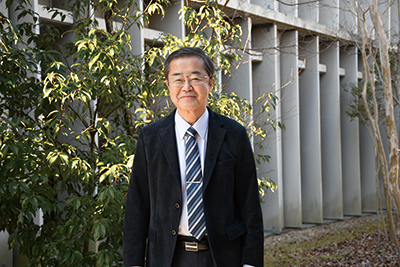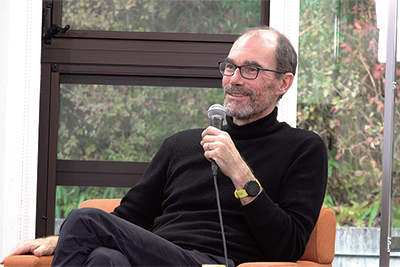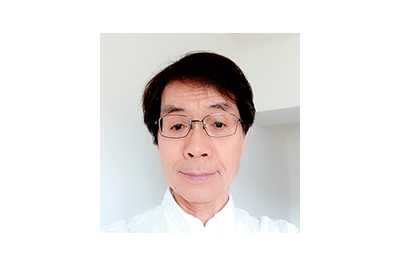Research Program 1
Societal Transformation under Environmental Change
SUGIHARA Kaoru
RIHNTrained in Japan (Doctorate at the University of Tokyo), I have held positions at the Faculty of Economics of Osaka City University, the History Department of the School of Oriental and African Studies, University of London, the Graduate School of Economics of Osaka University, the Center for Southeast Asian Studies, Kyoto University, the Graduate School of Economics of the University of Tokyo, and the National Graduate Institute for Policy Studies (Japan). My research concerns the history of intra-Asian trade, labour-intensive industrialization and the economic and environmental history of Monsoon Asia in long-term perspective. I am currently working on the historical interpretation of decarbonization.
| Researchers | |
| YAMAMOTO Aya | Research Associate |
| IWASAKI Yumiko | Research Associate |
This program aims at providing realistic perspectives and options to facilitate the transformation towards a society that can flexibly respond to environmental changes caused by human activities such as global warming and air pollution, as well as to natural disasters. To demonstrate the significance of global environmental sustainability for human society, we need to make intellectually explicit the links between environmental change on the one hand, and social issues such as livelihood, inequality, social security and conflict on the other, and reinforce understanding of these links in the real world.
The Program follows two lines of inquiry. The first conducts research on Asia’s long-term paths of social and economic development in relation to climate change and environmental history. Such studies offer historical understandings of the human-nature interface. For example, postwar development of the industrial complex along Asia’s Pacific coast was made possible by the combination of imported fossil fuels and utilization of rich local resources of land, water and biomass. Urban and industrial development in the region produced both rapid economic growth and severe environmental pollution and degradation (see Figure 1). By the beginning of this century the more global set of issues such as global warming, loss of biodiversity as a result of tropical deforestation and marine plastic waste were added (see Figure 2). It is important to recognize the causes and consequences of these historical processes in their own light, as well as for their significance to future societal change and policy deliberations.
The Program’s second line of inquiry examines the kinds of motivations that affect peoples’ livelihoods and seeks social transformation of norms and institutions by working closely with various stakeholders in local society. The peatland project in Sumatra identified four principal kinds of motivations—local livelihood, profit of local farmers and agricultural and industrial enterprises, local and centrally-based governance, and conservation measures implemented by governments, NGOs and international institutions—and examines how they can be best coordinated to promote sustainability at the village level. Photo 1 captures the peatland fire, a source of severe environmental problems and health hazards. Meanwhile, the ecosystem-based disaster risk reduction project investigates the potentiality of ecosystem services to address natural disaster risks in Japan, where population decline creates additional dimensions to this issue, which are becoming relevant in other Asian countries. Photo 2 shows a traditional Japanese device which serves for flood control and preservation of ecosystem services. Another project on Punjab, India, studies how to prevent stubble burning, a result of the introduction of a compressed double cropping calendar after the Green Revolution, which caused pressure on water and land, as well as air pollution and health hazards. Air pollution travels far and wide, and exhibits multiple connections of environmental issues on a large scale. Figure 3 reveals the remarkable impact of near nation-wide lockdowns as a result of the COVID-19 on atmospheric nitrogen dioxide concentrations.
As a whole, Program 1 attempts to capture the temporal and spatial depths of such research projects, and to create a framework and vision for their analysis.
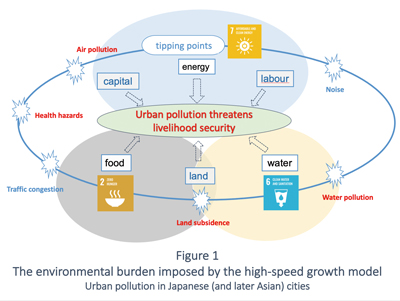
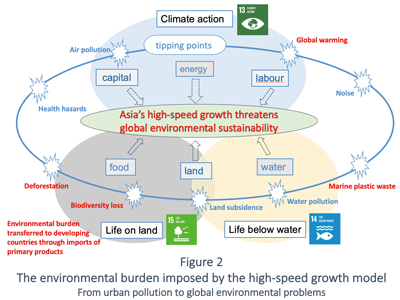
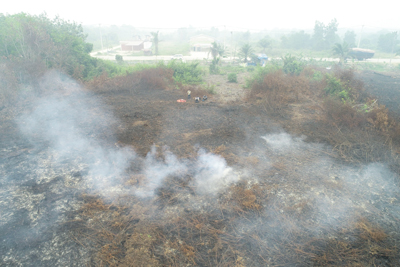
Photo 1 :
A drone view of tropical peat fires, Pelalawan district, Riau Province, Indonesia. Photo taken on September 13th, 2019.
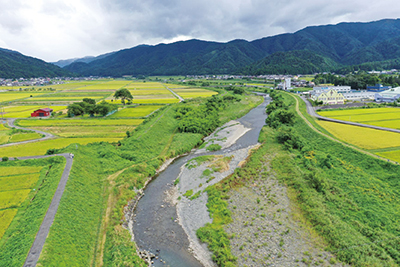
Photo 2 :
Kasumi-tei (open levee), a traditional measure against riverine flood, remaining in the Kitagawa River (Fukui Prefecture). Many open levees still exist in this river and perform multiple functions including flood control and supporting biodiversity and ecosystem services in the watershed. Photo taken in September 2020.
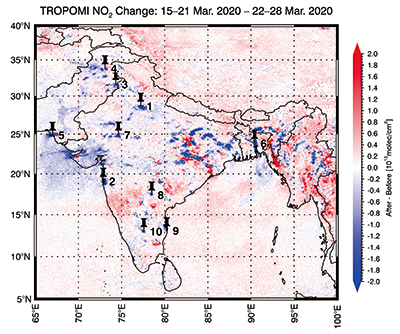
Figure 3 :
Changes in nitrogen dioxide concentrations before and
after lockdown in India, observed with satellite sensor (TROPOMI). Areas marked blue show a decrease, those marked red an increase. Pinned spots indicate major cities: 1. Delhi; 2. Mumbai; 3. Lahore; 4. Islamabad; 5. Karachi; 6. Dhaka; 7. Chittorgarh; 8. Hyderabad; 9. Chenna; and 10. Bangalore. See also pages 16-17.
Research Program 2
Fair Use and Management of Diverse Resources
MALLEE, Hein
RIHNHein MALLEE is a social scientist with a Ph.D. from Leiden University, the Netherlands. His work was initially concerned with migration and related policies in China, but as he started working in nternational development, he became involved in projects on rural development, natural resources management and poverty alleviation in China and Southeast Asia. The dominant theme in this work was local people’s involvement in and rights to resources. He has been a professor at RIHN since March 2013 and a deputy director-general since April 2018. He is also the director of the Regional Center for Future Earth in Asia.
| Researchers | |
| KOBAYASHI Kunihiko | Researcher |
| KARATSU Fukiko | Research Associate |
Global environmental problems are inter-related. Studies concentrating on single issues are therefore often not effective and consideration of the links between multiple resources involving stakeholders is essential. Recently, the nexus structure linking energy, water and food production has become a prominent area of study, but truly sustainable societies require more comprehensive understandings of the ecological resources that provide ecosystem services and cultural resources. The production, circulation and consumption of resources should be discussed in relation to a range of spatial scales, and stakeholders should be involved in these discussions. Sustainable use of resources requires fair and wise management systems as well as indices capable of managing these processes.
Many existing socio-economic or human behavioral systems must be converted or transformed into new systems capable of addressing the special qualities of renewable natural resources, as these qualities have sometimes been externalized from conventional economics. Asia is experiencing rapid change in economy, urbanization and population, though traditional techniques for sustainable resource management, associated with the relatively rich human sphere and cultural background in this region also survive. Study of this long-standing Asian experience of resource use may offer important observations about sustainability in general.
RIHN research projects have accumulated information and suggestions necessary to this transformation in resource management, though gaps remain. Program Two therefore explores wise and fair management systems capable of addressing multiple resource-uses by multiple stakeholders, in multi-spatial scales. We encourage new project proposals including those by innovative young scientists addressing such novel and under-examined subjects. Program research should also address the social conditions that support transformation of values and human behavior, as they should also inform new indices and institutions for fair resource management.
In 2019, we enlarged our database of resource supply and demand in Japan to the municipality level, with particular emphasis on ecosystem services. The database could be utilized to assist comparative and integrative analyses of research sites. One initial analysis of this database indicated that prefectural sustainability is related to population density. Some of these results were presented in the chapter "Evaluating local sustainability, including ecosystem services provided by rural areas to cities to promote bioeconomy" (The Bioeconomy Approach, Routledge 2020). It is also useful to consider the inter linkages among the resource use sustainability, which could be developed to address SDG targets.
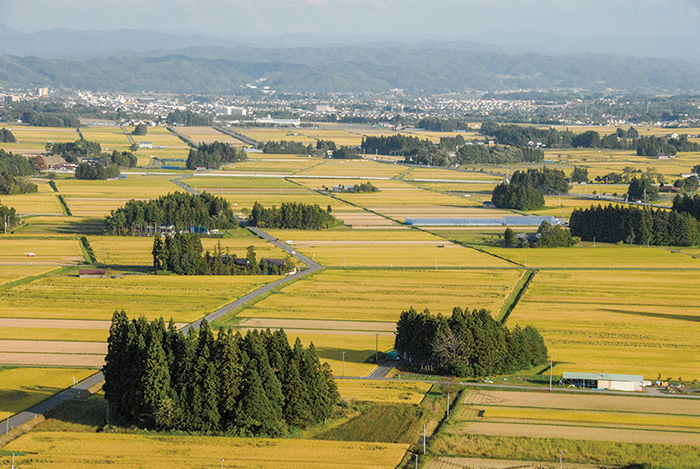
Traditional agricultural landscape in Hanamaki, Iwate Prefecture, Japan
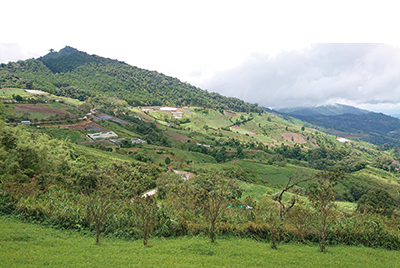
Land-use pattern in mountain area in Thailand
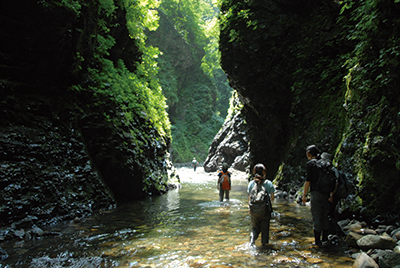
Water flow in upstream of Iwaki River, Japan
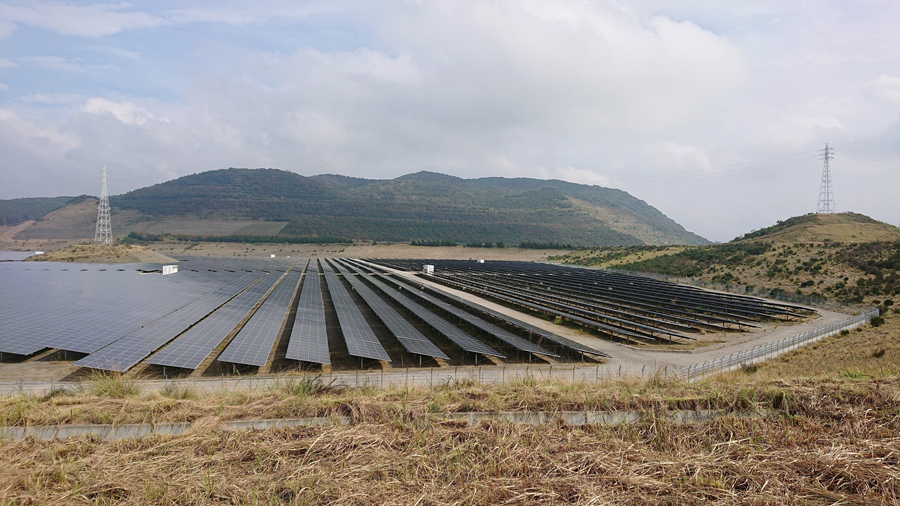
Solar power generation in Chiba Prefecture, Japan
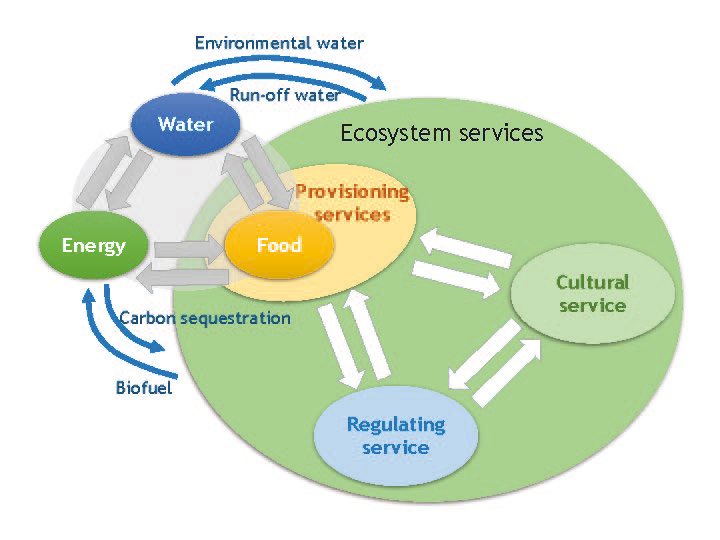
Nexus structure among water, energy, food, and ecosystem services
Research Program 3
Designing Lifeworlds of Sustainability and Wellbeing
SAIJO Tatsuyoshi
RIHNTatsuyoshi Saijo specializes in designing social systems that promote sustainability and equity without inhibiting individual incentive. His interest is in developing the field of “Future Design”, one that links the happiness and wellbeing of current generations to that of future generations.
| Researchers | |
| SHAHIRIER, Shibly | Researcher |
More than 60% of the world’s population resides in Asia and over a third of global economic activity occurs there. Asia is comprised of an incredible diversity of cultures, histories, societies, economies, livelihoods, and ecologies. Asia is also affected by myriad global and local environmental issues, such as population increase, air, water, soil, and coastal pollution, increasing greenhouse gas emissions, and biodiversity loss. The region is also affected by growing wealth disparity, social isolation, rising levels of poverty, and the disappearance of traditional cultures and knowledge. The combination of migration between the countryside and cities, rural depopulation, and urban concentration is accompanied by rapid socio-cultural change, over-exploitation of resources, and deterioration of natural environments. Both urban and rural lifeworlds are disintegrating rapidly.
In reconstructing the lifeworld concept and highlighting the reciprocal linkages between rural and urban spaces, Program 3 designs lifeworlds of sustainability and wellbeing and co-creates concrete pathways for their realization. Program research is based on the diverse world-views and accumulation of experience of human-nature co-existence. Latent socio-cultural elements such as livelihood styles, lay knowledge, conflict resolution strategies, and the vitality of the people themselves, can be called upon to address contemporary problems and to help chart a course toward possible future societies. Program 3 builds upon such experience and knowledge of human-nature interaction to propose concrete changes needed to achieve a sustainable society.
The transformations and frameworks leading to sustainable urban and rural lifeworld design will also entail fundamental shifts in existing economic systems, markets, and political decision-making systems. Rather than investigating top-down approaches to system change, Program 3 works with local residents, government officials, companies, citizen groups and other stakeholders to propose sustainable alternatives and gauge their feasibility. In order to avoid the risk of developing proposals that are only applicable to specific regions or sites, Program 3 will aim for research results that are generalizable while also retaining the diversity at the heart of local lifeworlds and wellbeing.
Intergenerational and intragenerational equity is an important issue in designing a sustainable society. Shibly Shahirier, a new researcher in the program, has found in a field experiment in Bangladesh that inequality can be greatly improved if people with power in the current generation think about current and future issues as imaginary future people. Stimulated by these results, at the Think 20 Summit, a preparatory meeting for the G20, the Program Director proposed that current world leaders be asked to act as imaginary future presidents and prime ministers of the world concerned to control carbon and nitrogen emissions, for example, which will place a heavy burden on future generations. Unfortunately, this proposal was not adopted, but the idea still stimulates Program research, including in the forthcoming volume Future Design x Philosophy (Keiso Shobo Publishers).

The diversity of fruits and vegetables for sale at the market in Kanchanaburi reflect Thailand’s changing society
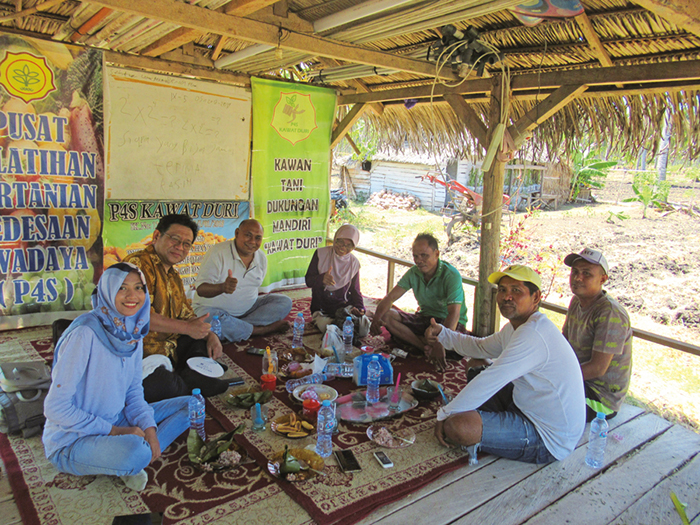
An activities of transdisciplinary community of practice in Hayahaya village of Gorontalo Province, Indonesia
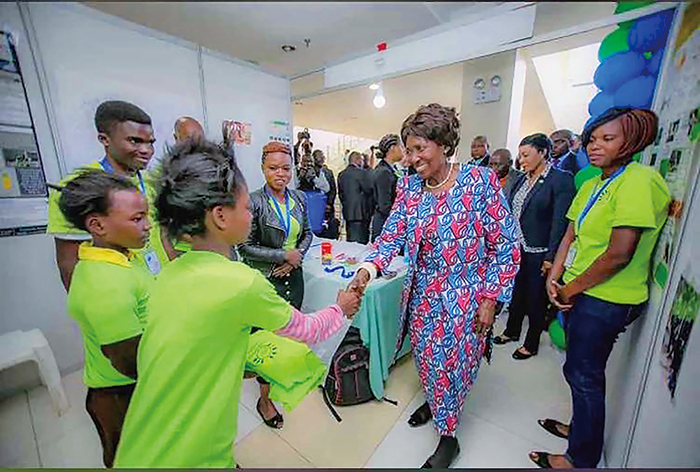
Action research in Zambia. The Vice-President of Zambia visited the Sanitation Project's booth at the Zambia Water Forum and Exhibition (ZAWAFE) 2018. Photo by NYMBE, Sikopo P.

